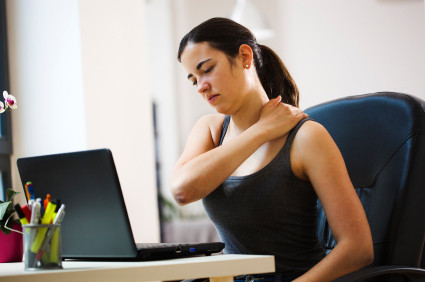Before we consider how massage works and how it can help resolve musculoskeletal pain we need to look at some of the ways the muscular system can become dysfunctional. Therapists are often asked ‘what caused my problem?’ and the answer, unfortunately, is not always simple. In the next two articles we will follow the process of dysfunction for two common causes of neck and shoulder pain.
There is an interesting moment in the BBC News 24 countdown sequence. The tension builds as the drums beat and the pips match the time signal. Images of various correspondents, working both home and abroad, are flashed across the screen until we see John Simpson talking to camera in a war zone. An explosion occurs behind him and John, the consummate professional, continues to speak to camera. His body does react however. In fact all the people around him react in the same way. His head drops down and his shoulders rise up as he ducks.


The body is well designed to protect vulnerable areas. The major nerves and blood vessels in the arms and legs run down the inner surface of the limbs. The femoral artery for example runs down the less exposed inner thigh. But one area of the body is very vulnerable and not well protected at all – the neck. The instinctive reaction of John Simpson is designed to make the body a smaller target but also designed to protect the exposed neck and throat. The shoulders rise up as the head drops down and the back stoops. This instinctive reaction lasts just a second or two before his posture returns to normal.
We moved house recently, apparently one of the most stressful things you can do in normal life and whenever I took time to notice I found my shoulders were nearly up to my ears with the stress. Now Plymouth is hardly a war zone, so what is happening here? The body finds it difficult to distinguish between instantaneous fight or flight situations and the insidious stress we feel in our everyday lives and the physical reactions can be remarkably similar.

How Does Stress Cause Neck and Shoulder Pain? Holding the shoulders in this raised position causes the neck and shoulder muscles to become shortened and tight. The muscles become strained particularly at the tendons where they join the area of bone at the back of the skull called the occiput. The associated discomfort, the aching shoulders and a sore neck, will be familiar to most of us. The hyperventilation and ‘chest breathing’ associated with stress exacerbate the situation still further as a band of tightness around the chest develops.
Under normal circumstances after the stress is resolved, the tension in the muscles dissipates relatively quickly; a good night out with friends, a relaxing holiday or a massage is usually sufficient to relax the muscles. In a later article we will look at the cascade of events that can lead to chronic neck and shoulder pain and even injury.
Interestingly, although stress and tight muscles can lead to headaches, latest research suggests that tension headaches may be caused or at least prolonged by taking too many painkillers over a period of time. Some people are trapped in a “vicious cycle” of taking medication for pain relief, which then causes even more headaches. The warning came as part of the National Institute for Health and Clinical Excellence’s (NICE) first guidelines for treating headaches.
In light of this research it becomes a matter of some urgency to find an alternative to taking pain killers for headaches. Fortunately, plenty of research has been done to investigate the effect of massage therapy on chronic non-migraine headaches and stress.
Research and further reading
1m Britons have Headaches from Overusing Painkillers
Article and video in The Guardian: Experts say pills people take to relieve headaches and migraines may be making things much worse
Neck movement and muscle activity characteristics in female office workers with neck pain.
Massage Therapy and Frequency of Chronic Tension Headaches
Compared with baseline values, headache frequency was significantly reduced within the first week of the massage protocol.
Conclusion – The muscle-specific massage therapy technique used in this study has the potential to be a functional, non-pharmacological intervention for reducing the incidence of chronic tension headache.
Massage Therapy for Stress Management: Implications for Nursing Practice
Research suggests massage has a direct relationship with positive health outcomes and patients’ perceptions of stress and anxiety were significantly reduced.
Research for Evaluation of Stress Change via Thermotherapy and Massage.
Jeong I, Jun S, Park S, Jung S, Shin T, Yoon H.
Department of Biomedical Engineering, Yonsei University, Wonju, Kangwon, 220-840, Korea. decem31@chol.com
The physiological changes of subjects before and after treatment were compared, the present research was able to prove that thermotherapy and massage treatment induces physiological change of patients thus relieves stress.
Physiological and clinical changes after therapeutic massage of the neck and shoulders
Sefton JM, Yarar C, Carpenter DM, Berry JW.
Neuromechanics Research Laboratory, Department of Kinesiology, Auburn University, Auburn, AL 36849-5323, USA. jmsefton@auburn.edu
This study investigated the influence of a standardized clinical neck/shoulder therapeutic massage intervention on physiological measures assessing α-motoneurone pool excitability, muscle activity; and the clinical measure of range of motion (ROM) compared to a light touch and control intervention. Flexor carpi radialis (FCR) α-motoneurone pool excitability (Hoffmann reflex), electromyography (EMG) signal amplitude of the upper trapezius during maximal muscle activity, and cervical ROM were used to assess possible physiological changes and clinical effects of therapeutic massage.
The intervention produced increases in cervical range of movement in all directions assessed. Therapeutic massage of the neck/shoulders reduced the α-motoneurone pool excitability of the flexor carpi radialis after therapeutic massage. Moreover, decreases in the normalized EMG amplitude during MVIC of the upper trapezius muscle; and demonstrated increases in cervical ROM in all directions assessed occurred after therapeutic massage.

Helpful information. Fortunate me I found your site
by chance, and I am shocked why this twist of fate did not happened
earlier! I bookmarked it.